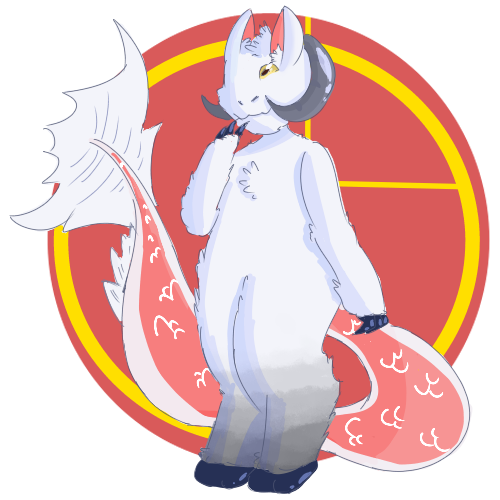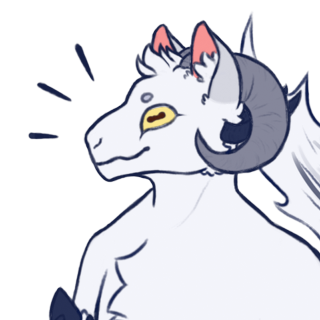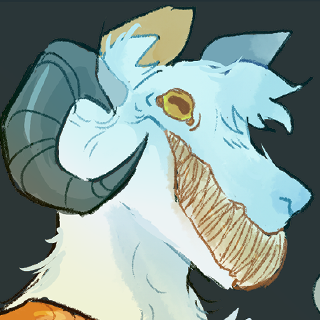[Cosmosdex] The Universal Encyclopedia
[Cosmosdex]
Kapricanus
Piranha / Biters
Kapricanus

Art by, Luce
- Strength-10
- Intelligence-2
- Charisma-1
- Endurance-5
- Agility-6
- Luck-2
Common Jobs: Fishermen, Lifeguards, Aquarists
Likes: Tradition, Craftsmanship, Fish, Family
Dislikes: Everything at least once
Attack Method: Strong tail and heavy mass- tackles and tramples.
Attributes
Homeplanet: Unknown/Not ImportantLifespan: 150 years
Size: 8 ft tall
Diet: Fish, Meat
Bodytype: Tailed Bipedal
Type: Marine-dwelling Mammal
Social Class: Low Class
Rarity: Rare
Common Traits
This character likes to use simple words and has little care for etiquette. They have an easier time getting along with lower class or less intelligent characters, but characters in higher rungs of society may see them as stupid or rude.
This character is more able to survive in an unfavorable environment, given time. This character is able to handle radical changes without folding under pressure.
This character commonly puts anyone around them on edge by presence alone. Everyday they are with someone, the sanity of the person goes slightly down.
Gods
They worship no gods, and are indifferent towards religion in general.
Gods: None / Not important
Original Creator: Starlit Drakon
Physical Description
A large, goat-like species, bearing close resemblance to the archetypal fish-tailed goat creature. The kapricanus is mostly piscivorous, transitioning from a carnivorous diet as fry to a fish-only diet as adults. A kapricanus fry resembles a small adult, albeit with shorter horns and much smaller limbs. An adult kapricanus is tall, with a pair of spiraling horns wrapping around their ears.
From the front, a kapricanus closely resembles a scaleless baphometti-- however, once a kapricanus show its teeth or tail, the resemblance is broken. A kapricanus has a mouth crammed with long, thin, needle-sharp teeth, much like an anglerfish. These teeth, when a kapricanus has their mouth closed, fold back against the inside of the kapricanus' mouth like the fangs of a snake. A kapricanus also has a fin on its back, though the length of the fin varies from kapricanus to kapricanus, a longer fin equaling a more aquatic kapricanus. This species also has a long, fishlike tail to match, using the large fin on the end to propel them quickly through the water.
Personality
The kapricani are a nomadic species, travelling along the numerous aquatic landscapes that form their most comfortable habitats. Kapricani have been seen settling along ocean coasts, rivers, lakes, and rarely in swamps. There was one documented case of a clan of kapricani settling in a rice paddy, though the kapricani that were born that year were observed to be stunted and ill, as well as a reduced harvest of rice that year. Kapricani are generally kind to other water faring species, though tend to avoid them due to the nature of the swarms of their fry.
Young kapricani, known as fry, live as schools in bodies of water, and are equipped with far more piranha-like teeth than those of adults. These schools will swarm anything that enters their vicinity, devouring it piece by piece. When visiting a kapricanus camp, it is not unusual to see adult and juvenile kapricani with small bite marks from their younger counterparts.
History
Kapricani were found wandering in several tribes on a water-rich planet by an explorer. This explorer was the last in a long line of explorers from the same system who had discovered the planet before, but had been unfortunately devoured by the swarms of kapricani fry who dwelled in the waters there. The presence of various ruins and remains around the planet suggest that the kapricani were previously the slaves or pets of a now-extinct species. It is unknown what caused the demise of this species, but once they were gone, the kapricani became the top species of the planet. The kapricani were the last of the so-called "zodiac species" to join the space age, as they were unwilling to leave the planet they had roamed for centuries.
Subspecies
Waterbound: Though not a true subspecies, these kapricanus are bound to the water, whether through injury or preference can be difficult to tell. They are often found tending to the fry pools, or hunting fish to provide for the rest of their settlement.
Landbound: Much like waterbound kapricani, landbound kapricani are unable to return to the water, most often due to loss of their tails. These kapricani are often gloomy and depressed, unable to return to the waters which support kapricani life. This type of kapricanus is the most likely to be found eating small mammals, as they are unable to catch fish to sustain themselves.
Special
None.
Relationships
Ariesa: The ariesa and kapricanus dislike each other, but both have to admit that when the other says they're going to do something there is no lies or trickery. Both mean exactly what they bring to the table, and for that reason the ariesa and kapricanus will begrudgingly from pacts when times are tough.
BVo9: BVo9 and kapricornus are too compatible. They are both brutal, destructive nomadic species given to roaming the land in roaming packs. Individuals and groups from each species readily integrate into the other species' clans in order to complement a unit's offensive and defensive capabilities and total tactical range.
From time to time, a kapricornus will eat a weaker or slower BVo9 alive; other BVo9 do not seem to take much offense at this and meet it with a shrug since, well, there are much duller ways to die.
Gemimi: Gemimi dislike and stay away from the kapricanus, feeling their thoughts on matters is an attempt at annoying others. Even when a gemimi has many puppets, all of them will seem to agree that kapricanus are not to be listened to. A rare moment where a gemimi actively agrees with themselves.
Carcili: The kapricanus and carcili are the best friends. The carcili normally convince the kapricanus to vote on situations that they agree with, as the lack of solid goverment and numbers in the carcili system means that carcili have less voting powers than all other species in the zodiac system. By teaming up with the kapricanus they can make sure they get some pushing power with their votes. The carcili in return give the kapricanus some much needed space on their home planet.
Leo: The leos attempt their best to get the kapricanus to interact with the rest of the system, but the kapricanus being as stubborn as they are always reject any changes, which leos are always pushing for. When the leos first landed on the kapricanus planet to bring the kapricanus to the space age, the kapricanus sunk right back into their waters, possibly flipping off the leos as they did so.
Virgora: The virgora and kapricanus seem like an odd fit, but both support each other when issues arise. Both species are slower to change, the kapricanus much more so than the virgora, so the kapricanus attach themselves to the virgora as allies who they know aren't going to destory their nerves by suddenly changing the game in the middle of things.
Libraille: The libraille and the kapricanus commonly butt heads, as the kapricanus want the least amount of change possible, while the libraille want to rip off the bandage and bring about a positive change as soon as possible. While the libraille and kapricanus get in long heated arguements at the table, both hold a bit of respect for the other holding their ground and presenting their arguements without lowering themselves to mudslinging. As such many zodiac debates start with a libraille and kapricanus debating against each other, and then everyone joining in.
Skokakrio: The kapricanus and skokakrio don't attempt to be on the same side as the other all the time, and yet time and time again the kapricanus and skokakrio can be seen constantly supporting the same issues. The kapricanus don't see why skokakrio seem to get such a bad rap, and are quick to call out other species who seem to be changing their choices on matters just because the skokakrio are supporting that choice. The kapricanus don't bother the skokakrio, and the skokakrio don't bother the kapricanus, and that's just how they like it.
Sagittari: The sagittari and kapricanus, on an indiviual level get along greatly. The two commonly hang around the other, even taking long trips into the wilderness with each other as the kapricanus are masters of water, while the sagittari are masters of land. There is one rule all of these friendships follow, don't talk about current events. When either talks about current events or social issues, both will quickly find themselves with a nasty taste in their mouth and a lost friendship. Likewise kapricanus and sagittari avoid each other when making votes. Commonly pretending after the vote that they are still on each other's goodside, even though truly they question each other more and more each vote.
Duckarium: The kapricanus and duckarium are constantly confused by each other. Each finds the other too alien for their tastes, and as such tend to just avoid each other, though not in a disrespectful or aggressive way.
Aqualisces: No one expected the kapricanus to react any differently to the aqualisces. Up until the aqualisces the kapricanus have been dismissive about everyone who came up to them, but the aqualisces were different. The two clicked right away. The kapricanus normally are near unwilling to hear someone explain why they should change something, but aqualisces know just the right way to explain things to kapricanus, and make the right comprises. The two might not agree on everything, but they like it that way, because of this they are able to learn from one another and change their thoughts on matters, but not feel like changing sides on something halfway through a discussion is negative in any way.
Trivia
• A kapricanus is considered an adult once their legs are able to support them on land. This can result in an "adult" kapricanus as young as five or as old as fifty, though they will remain smaller in size until they reach adulthood. It is unknown why this difference in size occurs, though many notails theorize it to be hormones triggered by some stimuli unique to leaving water.
• Kapricanus scales are glossy and reflective, much like glass or gems. Their tails are also often much brighter than their coats, or completely different colors altogether.
• They are often decorated in shed scales and shells- some individuals so much so that it can be hard to tell where their fur stops and their tails start!




